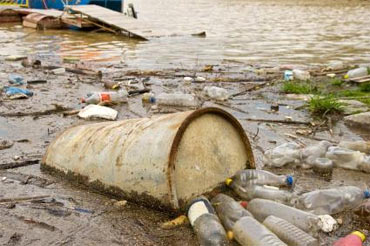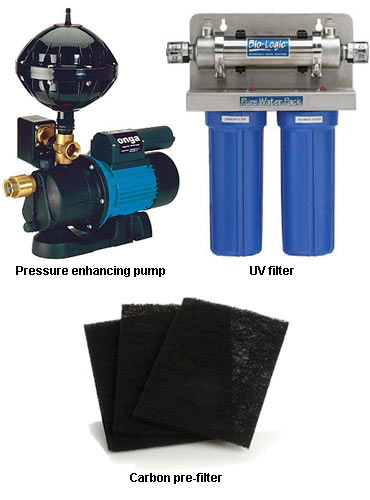 | « Back to article | Print this article |
Which water purifier is right for you?
Get Ahead reader Vijay Padiyar contributed this article in response to our reader invite (below).
A lot of people are under the misconception that reverse osmosis (RO)-based water purifiers are, in general, a better choice of water purifiers than ultraviolet (UV)-based ones. While this may be true in technological terms, it does not mean that a RO-based water purifier should be an automatic choice for every home.
This article explains how to decide whether to go in for a RO-based water purifier or stick to a UV-based one.
Osmosis and reverse osmosis
Let's start with the basics. RO stands for reverse osmosis. To understand how RO works, it is essential to understand osmosis first.
Osmosis, as we learnt in school, is the flow of water molecules across a semi-permeable membrane from a region of lower solute concentration to a region of higher solute concentration (see image).
The semi-permeable membrane above has holes, or gaps, that are large enough for water molecules to pass through, but too small for the solid molecules to move across.
In case of drinking water, solute refers to the dissolved salts and minerals such as Calcium and Magnesium (referred to as Total Dissolved Salts or TDS) that are present in unfiltered water.
Depending on the concentration of these dissolved salts (calculated in units of parts per million or PPM), water is classified as soft water or hard water. Soft water has less dissolved salts, while hard water has more dissolved salts.
RO attempts to do the opposite of osmosis, that is, move water molecules from a region of higher solute concentration to a region of lower solute concentration (hence the name reverse osmosis). It does this by using the pressure of the incoming water to push it across the membrane, while leaving the dissolved solids and other impurities behind. The remaining water and solids are discharged through another outlet (see image).
Click NEXT to get a low-down on the points to consider when choosing the right water purifier for your home.
Which water purifier is right for you?
Sources of water contamination
There are various sources of drinking water supply, such as lakes and rivers, bore wells, water tankers, harvested rain water, etc. Depending on the source of water, the quality of water supplied may differ in terms of TDS levels as well as presence of microorganisms such as viruses and bacteria.
Generally, water supplied from lakes and rivers, as well as harvested rainwater, will have a lower concentration of TDS, whereas water drawn from bore wells or supplied by tankers is likely to have a higher concentration of TDS and other harmful chemicals.
The amount of microorganisms in water can also vary depending on the quality and cleanliness of the water delivery infrastructure, such as treatment plants, pipelines, intermediate storage tanks, etc.
Old and/or corroded pipes are a major source of water contamination. And if a water pipe is placed close to a sewage pipe and leakage takes place, the contamination can be far more severe.
Similarly, tanks constructed to store water can also cause contamination if not cleaned regularly and properly.
In case of bore well water, factors such as the presence of factories or agricultural fields in the surroundings determine the presence of harmful chemicals in the water.
Check out: The all new Gadgets and Gaming page
Reader invite
Are you a gadget/gaming wizard? Would you like to write on gadgets, gaming, the Internet, software technologies, OSs and the works for us? Send us a sample of your writing to gadgetsandgaming@rediffmail.com with the subject as 'I'm a tech wizard' and we will get in touch with you.
Which water purifier is right for you?
RO-based water purifiers
RO-based water purifier uses the reverse osmosis technique explained earlier to remove dissolved salts, impurities and chemicals from the water.
Apart from the core components illustrated earlier, a commercial RO water purifier may have some additional components for better filtration and performance. These include:
Pressure enhancing pump: If the incoming water flow from the tap does not have an adequately high water pressure, the RO filter will not work optimally. In such cases, a pump is added before the RO filtration unit to boost the inlet water pressure.
UV filter: Some RO water purifiers add a UV-based purification stage after the initial RO-based filtration to further purify the water by controlled exposure to UV radiation. This is because while RO is good at removing impurities from water, it may not be capable of removing microorganisms completely. The UV stage kills any living organisms left over after the RO stage, thereby delivering completely pure water.
Carbon pre-filter: This is added to remove unpleasant odors from water, as well as chemicals like Chlorine added by water suppliers.
Check out: The all new Gadgets and Gaming page
Reader invite
Are you a gadget/gaming wizard? Would you like to write on gadgets, gaming, the Internet, software technologies, OSs and the works for us? Send us a sample of your writing to gadgetsandgaming@rediffmail.com with the subject as 'I'm a tech wizard' and we will get in touch with you.
Which water purifier is right for you?
When to use RO water purifiers
It should be obvious by now that a RO-based water purifier is really useful only if the water supply in your home has high levels of TDS and impurities. Therefore, before choosing which water purifier to buy, you should ask a qualified person to come home and check the quality of your water supply.
If the TDS in your water supply exceeds about 60 to 80 PPM, then it is advisable to install a RO-based water purifier. If not, then you are better off buying a standard UV-based water purifier.
Also, don't forget to check the water pressure at your house. If the inlet water pressure is below the stipulated level for the purifier, you may need a pump as explained above.
Normally, technicians of water purifier manufacturers are qualified to check the water quality and pressure with specialised equipment. So you can fix an appointment with any well-known water purifier manufacturer, and their technicians will come home, do the preliminary analysis and suggest the right type of purifier for your case.
Check out: The all new Gadgets and Gaming page
Reader invite
Are you a gadget/gaming wizard? Would you like to write on gadgets, gaming, the Internet, software technologies, OSs and the works for us? Send us a sample of your writing to gadgetsandgaming@rediffmail.com with the subject as 'I'm a tech wizard' and we will get in touch with you.
Which water purifier is right for you?
What to look for in a RO water purifier
There are various factors to keep in mind when choosing a specific RO water purifier model. These are:
RO membrane pore size: This is arguably the most important factor in a RO water purifier. Manufacturers indicate this indirectly by specifying the size of impurities that the purifier can block. Filtration up to 0.0001 microns is achievable currently.
Number of purifying stages: Based on your needs, you can either go for a RO-only purifier or a RO+UV purifier, with additional stages as necessary. Some purifiers also have stages to enhance the taste of the filtered water by making it sweeter.
Storage tank capacity: The capacity of the built-in storage tank should be adequate for your daily needs. This is because, unlike UV-based purification, RO-based purification is a slow process, and you wouldn't want to be waiting for the water to be purified because the tank inside got emptied.
Flow rate: As RO-based purification is slow, therefore, for commercial uses, it is also necessary to check the rate at which the purifier can deliver filtered water. The manufacturer in units of litres per hour usually indicates this.
Life span of RO membrane and UV lamp: Knowing the life span of these critical components will help you calculate your maintenance costs.
Lastly, as with any product, please remember to check the product reviews and the quality of after-sales service before narrowing down on any specific model.
Check out: The all new Gadgets and Gaming page
Reader invite
Are you a gadget/gaming wizard? Would you like to write on gadgets, gaming, the Internet, software technologies, OSs and the works for us? Send us a sample of your writing to gadgetsandgaming@rediffmail.com with the subject as 'I'm a tech wizard' and we will get in touch with you.
Which water purifier is right for you?
Pros and cons of RO technology
Pros:
Clean & effective: Delivers far more effective purification for water with high levels of TDS and impurities, and does so without the use of chemicals.
Removes all impurities: Apart from dissolved salts, it can also remove pesticides, metals, chemicals, etc. which typically seep into ground water from surrounding areas.
Multi-stage purification: Multiple stages can effectively filter out both living and non-living impurities, remove odors, enhance taste, etc.
Energy efficient: RO filtration itself does not require electricity, although other components such as the UV lamp or pump require it.
Cons:
Excessive water wastage: For every liter of water that is purified, about 3-4 liters of water are discharged as waste. Generally, the percentage of wastage reduces slightly as the capacity goes up.
Slow filtration process: As explained earlier, unlike UV purifiers, the RO filtration is quite slow, and so filtered water supply will not start as soon as the inlet water tap is turned on.
Removes essential minerals: Hard water is essentially water with high levels of Calcium and Magnesium. However, some amount of these minerals is actually good for the body and must be retained in drinking water. This is why a RO water purifier should not be used with soft water, as it will likely end up draining these minerals from the water completely.
Expensive: Being a relatively new technology, and because of the multiple filtration stages, RO water purifiers are currently quite expensive. A good RO water purifier can cost 2 to 4 times as much as a good UV water purifier.
Check out: The all new Gadgets and Gaming page
Reader invite
Are you a gadget/gaming wizard? Would you like to write on gadgets, gaming, the Internet, software technologies, OSs and the works for us? Send us a sample of your writing to gadgetsandgaming@rediffmail.com with the subject as 'I'm a tech wizard' and we will get in touch with you.





